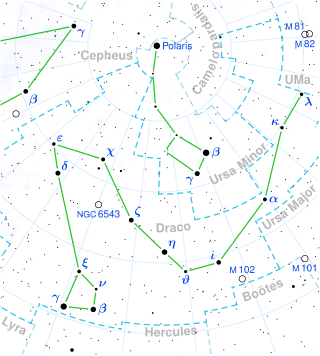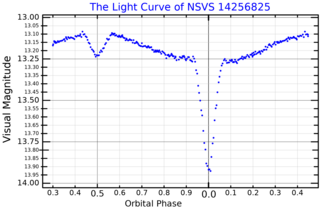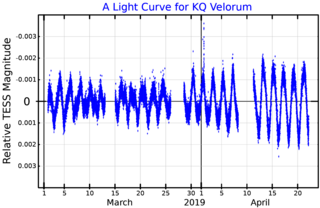Related Research Articles

Mintaka, designation Delta Orionis and 34 Orionis, is a multiple star system some 1,200 light-years from the Sun in the constellation of Orion. Together with Alnitak and Alnilam, the three stars form Orion's Belt, known by many names among ancient cultures. The star is located very close to the celestial equator. When Orion is near the meridian, Mintaka is the rightmost of the Belt's stars when viewed from the Northern Hemisphere facing south.

AE Aurigae is a runaway star in the constellation Auriga; it lights the Flaming Star Nebula.

HD 10307 is a spectroscopic binary star in the constellation Andromeda. The primary is similar to the Sun in mass, temperature and metal content. situated about 42 light-years from Earth Its companion, HR 483 B, is a little-studied red dwarf.

Chi Draconis is a magnitude 3.6 binary star in the constellation Draco. It also has the Flamsteed designation 44 Draconis. At a distance of 27 light years, it is one of the forty or so closest stars.
1 Centauri, or i Centauri, is a yellow-white-hued binary star system in the southern constellation Centaurus. It can be seen with the naked eye, having an apparent visual magnitude of +4.23. Based upon an annual parallax shift of 51.54 mas as seen from Earth's orbit, it is located 51.5 light-years from the Sun. The system is moving closer to the Sun with a radial velocity of −21.5 km/s.
HD 111232 is a star in the southern constellation of Musca. It is too faint to be visible with the naked eye, having an apparent visual magnitude of 7.59. The distance to this star is 94.5 light years based on parallax. It is drifting away from the Sun with a radial velocity of +104 km/s, having come to within 14.1 light-years some 264,700 years ago. The absolute magnitude of this star is 5.25, indicating it would have been visible to the naked eye at that time.
HD 142022 is a binary star system located in the southernmost constellation of Octans. It is too faint to be visible to the naked eye, having an apparent visual magnitude of 7.70. The distance to this system is 112 light-years based on parallax, but it is drifting closer to the Sun with a radial velocity of −10 km/s.

HD 150136 is a multiple star system in the southern constellation of Ara, around 4,300 light years away. It is the brightest member of the faint open cluster NGC 6193, part of the Ara OB1 association.

KPD 1930+2752 is a binary star system including a subdwarf B star and a probable white dwarf with relatively high mass. Due to the nature of this astronomical system, it seems like a likely candidate for a potential type Ia supernova, a type of supernova which occurs when a white dwarf star takes on enough matter to approach the Chandrasekhar limit, the point at which electron degeneracy pressure would not be enough to support its mass. However, carbon fusion would occur before this limit was reached, releasing enough energy to overcome the force of gravity holding the star together and resulting in a supernova.
HD 93403 is a spectroscopic binary containing two highly luminous hot blue stars. It is 10,000 light years away in the Carina Nebula in the constellation Carina. It appears to have spectral type O5.5III, but this is composed of two spectra from a blue supergiant and blue main sequence star of spectral type O5.5I and O7V respectively. The two stars orbit every 15 days with a separation that varies from 93 R☉ to 149 R☉. The binary is shedding mass at the high rate of 0.0005 M☉ per year.
λ Librae is the Bayer designation for a binary star system in the zodiac constellation of Libra. It can be faintly seen with the naked eye, having an apparent visual magnitude of 5.03. With an annual parallax shift of 10.54 mas, it is roughly 310 light years from the Sun. At that distance, the visual magnitude of this system is diminished by an extinction factor of 0.22 due to interstellar dust. It is 0.1 degree north of the ecliptic.

NSVS 14256825, also known as V1828 Aquilae, is an eclipsing binary system in the constellation of Aquila. The system comprises a subdwarf OB star and red dwarf star. The two stars orbit each other every 2.648976 hours. Based on the stellar parallax of the system, observed by Gaia, the system is located approximately 2,700 light-years away.

HR 273 is a chemically peculiar spectroscopic binary system in the northern circumpolar constellation of Cassiopeia. It has an apparent visual magnitude of 5.9 making it faintly visible to the naked eye from dark suburban skies. Parallax measurements with the Hipparcos spacecraft put this system at a distance of roughly 350 light years.
HD 136138, or HR 5692, is a binary star system in the Serpens Caput segment of the Serpens constellation. It has a golden hue like the Sun and is dimly visible to the naked eye with an apparent visual magnitude of 5.68; the light contribution from the companion is effectively negligible. This system is located at a distance of approximately 420 light years from the Sun based on parallax. It is drifting closer with a radial velocity of −7.7 km/s and has a proper motion of 23.5 mas·yr−1.
HD 219617 is a binary star system some 220 light-years away from the Solar System in the constellation Aquarius. It is composed of two metal-poor F-type subdwarf stars orbiting each other in a 388-year orbit. Another theory suggests that the binary star is composed of subgiant stars. Unlike many halo stars, which exhibit an excess of alpha elements relative to iron, HD 219617 is depleted in iron peak and alpha elements, although alpha elements concentrations are poorly constrained. The stellar chemical composition is peculiar, being relatively oxygen-enriched and extremely depleted in neutron capture elements. The helium fraction of the binary star at present cannot be reliably determined, and appears to be near the primordial helium abundance.

KQ Velorum is a variable star system in the southern constellation of Vela. It has the identifier HD 94660 in the Henry Draper Catalogue; KQ Vel is the variable star designation. This appears as a sixth magnitude star with an apparent visual magnitude of 6.112, and thus is dimly visible to the naked eye under suitable viewing conditions. The system is located at a distance of approximately 373 light years from the Sun based on parallax measurements, and is drifting further away with a radial velocity of around 23 km/s.
HD 72945 and HD 72946 form a co-moving star system in the northern constellation of Cancer. HD 72945 is a binary star that is dimly visible to the naked eye as a point of light with an apparent visual magnitude of 5.91. At an angular separation of 10.10″ is the fainter companion star HD 72946 at magnitude 7.25. It is being orbited by a brown dwarf. The system as a whole is located at a distance of approximately 84 light years from the Sun based on parallax measurements.

HD 4222, also known as HR 196, is the primary of a binary star located in the northern constellation Cassiopeia. It is faintly visible to the naked eye as a white-hued point of light with an apparent magnitude of 5.41. Gaia DR3 parallax measurements imply a distance of 353 light-years and it is drifting closer with a heliocentric radial velocity of −8.5 km/s. At its current distance, HD 4222's brightness is diminished by an interstellar extinction of 0.13 magnitudes and it has an absolute magnitude of +0.44.
References
- 1 2 3 4 5 Van Leeuwen, F. (2007). "Validation of the new Hipparcos reduction". Astronomy and Astrophysics. 474 (2): 653–664. arXiv: 0708.1752 . Bibcode:2007A&A...474..653V. doi:10.1051/0004-6361:20078357. S2CID 18759600.
- 1 2 3 Landolt, Arlo U.; Uomoto, Alan K. (2007). "Optical Multicolor Photometry of Spectrophotometric Standard Stars". The Astronomical Journal. 133 (3): 768–790. arXiv: 0704.3030 . Bibcode:2007AJ....133..768L. doi:10.1086/510485. S2CID 119672730.
- 1 2 3 4 5 Mereghetti, S.; La Palombara, N.; Tiengo, A.; Sartore, N.; Esposito, P.; Israel, G. L.; Stella, L. (2013). "X-ray emission from the luminous O-type subdwarf HD 49798 and its compact companion". Astronomy & Astrophysics. 553: A46. arXiv: 1304.1653 . Bibcode:2013A&A...553A..46M. doi:10.1051/0004-6361/201321271. S2CID 56402049.
- ↑ Pourbaix, D.; Tokovinin, A. A.; Batten, A. H.; Fekel, F. C.; Hartkopf, W. I.; Levato, H.; Morrell, N. I.; Torres, G.; Udry, S. (2004). "SB9: The ninth catalogue of spectroscopic binary orbits". Astronomy and Astrophysics. 424 (2): 727–732. arXiv: astro-ph/0406573 . Bibcode:2004A&A...424..727P. doi:10.1051/0004-6361:20041213. S2CID 119387088.
- ↑ Mereghetti, S.; Tiengo, A.; Esposito, P.; La Palombara, N.; Israel, G. L.; Stella, L. (2009). "An Ultramassive, Fast-Spinning White Dwarf in a Peculiar Binary System". Science. 325 (5945): 1222–1223. arXiv: 1003.0997 . Bibcode:2009Sci...325.1222M. doi:10.1126/science.1176252. PMID 19729650. S2CID 206521141.
- 1 2 3 4 Kudritzki, R. P.; Simon, K. P. (1978). "Non-LTE analysis of subluminous O-star. The hydrogen-deficient subdwarf O-binary HD 49798". Astronomy and Astrophysics. 70: 653. Bibcode:1978A&A....70..653K.
- 1 2 New X-ray observations of the hot subdwarf binary HD 49798/RX J0648.0–4418, 2021, arXiv: 3104.03867
- 1 2 3 Chen, Wen-Cong (2022). "X-ray pulsar HD 49798: A contracting white dwarf with a debris disk?". Astronomy & Astrophysics. 662: A79. arXiv: 2205.09982 . Bibcode:2022A&A...662A..79C. doi:10.1051/0004-6361/202243536. S2CID 248965211.
- ↑ Jaschek, Mercedes; Jaschek, Carlos (1963). "HD 49798, a New O-Type Subdwarf". Publications of the Astronomical Society of the Pacific. 75 (445): 365. Bibcode:1963PASP...75..365J. doi:10.1086/127968.
- ↑ Thackeray, A. D. (1970). "The spectroscopic orbit of the O-type subdwarf HD 49798". Monthly Notices of the Royal Astronomical Society. 150 (2): 215–225. Bibcode:1970MNRAS.150..215T. doi: 10.1093/mnras/150.2.215 .
- ↑ Bisscheroux, B. C.; Pols, O. R.; Kahabka, P.; Belloni, T.; Van Den Heuvel, E. P. J. (1997). "The nature of the bright subdwarf HD 49798 and its X-ray pulsating companion". Astronomy and Astrophysics. 317: 815. Bibcode:1997A&A...317..815B.
- ↑ Wang, Bo; Han, Zhanwen (2012). "Progenitors of type Ia supernovae". New Astronomy Reviews. 56 (4): 122. arXiv: 1204.1155 . Bibcode:2012NewAR..56..122W. doi:10.1016/j.newar.2012.04.001. S2CID 118740933.
- ↑ Liu, Dong-Dong; Zhou, Wei-Hong; Wu, Cheng-Yuan; Wang, Bo (2015). "Is the X-ray pulsating companion of HD 49798 a possible type Ia supernova progenitor?". Research in Astronomy and Astrophysics. 15 (11): 1813. arXiv: 1504.01461 . Bibcode:2015RAA....15.1813L. doi:10.1088/1674-4527/15/11/004. S2CID 118683249.